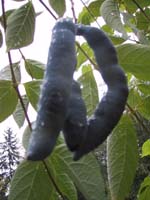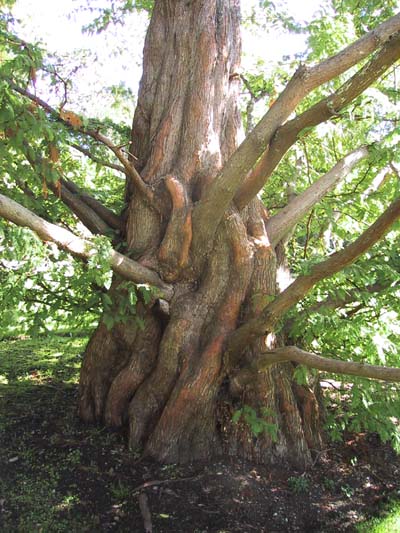autumn rain
Well the torrential autumn rains are here and the howling south east winds are pounding the island. The power is going on and off and the roads are covered with migrating rough-skinned newts
I’ve always liked having a few ‘monotypic’ trees and shrubs around, particularly those native to the curious Metasequoia area of central China – truly a land of living fossils!
High on my list of favorites, (other than the magnificent Metasequoia itself), is the Decaisnea fargesii – the blue bean tree.
My Decaisnea is sporting its first crop of plump, metallic blue pods, each containing an edible sweet, viscous jelly, that encases numerous dark black seeds. I first came upon this botanical marvel, seven years ago, at Vancouver’s Van Dusen Botanical Gardens. Its fallen blue pods had covered the walkway with a sweet slime, reminiscent of the aftermath of an orgy of slugs. I collected a few seeds which I germinated the following spring (after stratification in my refrigerator.)
The seedlings grew quite rapidly and my present Decaisea is really the result of two (or three) of the original seedlings, having grown into each other into a clump about 2.5 metres high.

My Decaisnea fargesii 10/03
Of course the “living fossil” Metasequoia glyptostroboides continues to enchant me. I now have several growing around our place and they seem to be thriving in our temperate, oceanic climate. Perhaps they ‘remember’ having grown here in prehistory, their genetic databanks attuned to a much greater climate range than is presently experienced in the last wild groves, still growing precariously in the isolated valleys of central China. Unusual among conifers, Metasequoia is deciduous. Their soft needles are now turning to a handsome bronze colour, before they are shed completely for the winter.
I came upon this highly picturesque old specimen on the grounds of the Governor-General’s residence in Victoria BC. It must have been magnificent when dense forests of this now relic species covered Western North America. Although critically endangered in the wild, it is fortunate that Metasequoia is common in cultivation, although most of them are from a dangerously small gene pool. I once found a fossilized imprint of some Metasequoia leaves on a small piece of sandstone, behind a baseball field in the (aptly named) town of Fossil, Oregon which dated from the Tertiary period. They were virtually indistinguishable from the leaves of the tree that you see here.

Picturesque Metasequoia, Victoria BC
I love this tree so much that I decided to use it as my ‘portrait’ for my account in my nascent plone site. My regular readers will have been following my travails with plone, but I finally think I have gotten the hang of it (at least enough to start building a working site.) The great thing about plone is that it enables wikis, (actually Zwikis) , which are easy to use, easy to create, little collaborative websites. These will be hang-out places for my permaculture students and other collaborators where we will be able to compare notes and have linked conversations. I’ll link to oliverk.org through this blog and on my oliverk.com menu page. I realize I’m not really a “dot-com” kind of guy and will slowly map everything over to the .org domain.
But to the unitiated little baby ‘plonista’, like yours truly, there seems to be too much to keep up with. Plone is growing by leaps and bounds and there is an endless process of upgrading and discussion. That’s the beauty of open-source. Still, it’s amazing that I could cobble together an interactive, multi-user, collaborative web site at all, *in just a few days.* And I really don’t know anything. Such is the power of plone.
For many of us, keeping up with all there is read on topics we are interested in, has become well nigh impossible. Apparently my sentiments are shared by much of the scientific community. Enter: ‘text mining’ Unlike simple search engines like Google:
Text-mining programs go further, categorizing information, making links between otherwise unconnected documents and providing visual maps (some look like tree branches or spokes on a wheel) to lead users down new pathways that they might not have been aware of. (and) Lower-cost text-mining tools eventually will be offered to ordinary people who want to dig into medical or political issues using public documents. Madan Pandit, an expert in text analysis in Bangalore, India, who runs a Web site called K-Praxis (k-praxis.com), has suggested that text mining could help people make sense of voluminous documents that are already on the Web, like the 858-page report on the congressional inquiry into intelligence failures regarding the 9/11 terrorist attacks.
Maybe text mining software will make us all more effective activists. The ‘visual maps’ sound extremely intriguing. The idea of being able to plot (visually) the *relationships* between news items might make it all the easier for us to spot the ‘man behind the curtain.’



